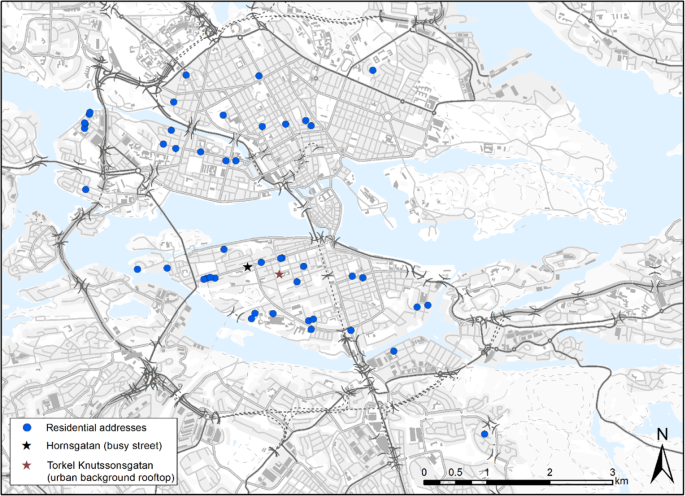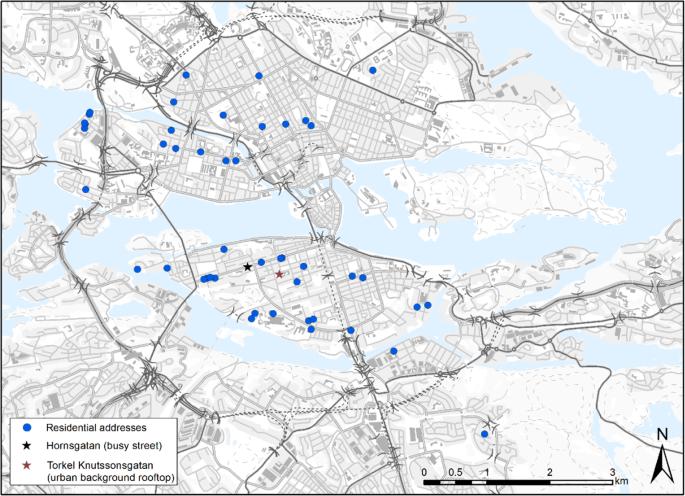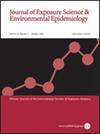Comparison of personal exposure to black carbon levels with fixed-site monitoring data and with dispersion modelling and the influence of activity patterns and environment
IF 4.1
3区 医学
Q2 ENVIRONMENTAL SCIENCES
Journal of Exposure Science and Environmental Epidemiology
Pub Date : 2024-02-22
DOI:10.1038/s41370-024-00653-2
引用次数: 0
Abstract
Short-term studies of health effects from ambient air pollution usually rely on fixed site monitoring data or spatio-temporal models for exposure characterization, but the relation to personal exposure is often not known. We aimed to explore this relation for black carbon (BC) in central Stockholm. Families (n = 46) with an infant, one parent working and one parent on parental leave, carried battery-operated BC instruments for 7 days. Routine BC monitoring data were obtained from rural background (RB) and urban background (UB) sites. Outdoor levels of BC at home and work were estimated in 24 h periods by dispersion modelling based on hourly real-time meteorological data, and statistical meteorological data representing annual mean conditions. Global radiation, air pressure, precipitation, temperature, and wind speed data were obtained from the UB station. All families lived in the city centre, within 4 km of the UB station. The average level of 24 h personal BC was 425 (s.d. 181) ng/m3 for parents on leave, and 394 (s.d. 143) ng/m3 for working parents. The corresponding fixed-site monitoring observations were 148 (s.d. 139) at RB and 317 (s.d. 149) ng/m3 at UB. Modelled BC levels at home and at work were 493 (s.d. 228) and 331 (s.d. 173) ng/m3, respectively. UB, RB and air pressure explained only 21% of personal 24 h BC variability for parents on leave and 25% for working parents. Modelled home BC and observed air pressure explained 23% of personal BC, and adding modelled BC at work increased the explanation to 34% for the working parents. Short-term studies of health effects from ambient air pollution usually rely on fixed site monitoring data or spatio-temporal models for exposure characterization, but the relation to actual personal exposure is often not known. In this study we showed that both routine monitoring and modelled data explained less than 35% of variability in personal black carbon exposure. Hence, short-term health effects studies based on fixed site monitoring or spatio-temporal modelling are likely to be underpowered and subject to bias.


通过固定地点监测数据和散布模型以及活动模式和环境的影响,比较个人接触黑碳的水平。
背景:环境空气污染对健康影响的短期研究通常依赖于固定地点的监测数据或时空模型来描述暴露特征,但与个人暴露的关系通常并不清楚:我们旨在探索斯德哥尔摩市中心黑碳(BC)的这种关系:方法:有婴儿的家庭(n = 46),父母一方工作,一方休育儿假,携带电池供电的黑碳监测仪 7 天。从农村背景(RB)和城市背景(UB)地点获得了常规 BC 监测数据。根据每小时的实时气象数据和代表年平均状况的统计气象数据,通过弥散模型估算出家庭和工作场所 24 小时内的室外 BC 水平。全球辐射、气压、降水、温度和风速数据均来自 UB 站。所有家庭都住在市中心,距离 UB 站 4 公里以内:休假父母的 24 小时个人 BC 平均水平为 425(标准差 181)纳克/立方米,工作父母的 24 小时个人 BC 平均水平为 394(标准差 143)纳克/立方米。相应的固定地点监测观测值为:经常预算 148(标准差 139)纳克/立方米,综合预算 317(标准差 149)纳克/立方米。家庭和工作场所的模拟 BC 水平分别为 493(s.d. 228)纳克/立方米和 331(s.d. 173)纳克/立方米。对于休假的父母,UB、RB 和气压只能解释个人 24 小时 BC 变异的 21%,而对于工作的父母,只能解释 25%。模拟的家庭 BC 和观测到的气压可解释 23% 的个人 BC,而加入模拟的工作时 BC,则可将在职父母的个人 BC 解释率提高到 34%:影响:环境空气污染对健康影响的短期研究通常依赖于固定地点的监测数据或时空模型来描述暴露特征,但与实际个人暴露的关系通常并不清楚。在这项研究中,我们发现常规监测数据和模型数据对个人黑碳暴露变化的解释都不到 35%。因此,基于固定地点监测或时空建模的短期健康影响研究很可能缺乏说服力,并可能出现偏差。
本文章由计算机程序翻译,如有差异,请以英文原文为准。
求助全文
约1分钟内获得全文
求助全文
来源期刊
CiteScore
8.90
自引率
6.70%
发文量
93
审稿时长
3 months
期刊介绍:
Journal of Exposure Science and Environmental Epidemiology (JESEE) aims to be the premier and authoritative source of information on advances in exposure science for professionals in a wide range of environmental and public health disciplines.
JESEE publishes original peer-reviewed research presenting significant advances in exposure science and exposure analysis, including development and application of the latest technologies for measuring exposures, and innovative computational approaches for translating novel data streams to characterize and predict exposures. The types of papers published in the research section of JESEE are original research articles, translation studies, and correspondence. Reported results should further understanding of the relationship between environmental exposure and human health, describe evaluated novel exposure science tools, or demonstrate potential of exposure science to enable decisions and actions that promote and protect human health.

 求助内容:
求助内容: 应助结果提醒方式:
应助结果提醒方式:


